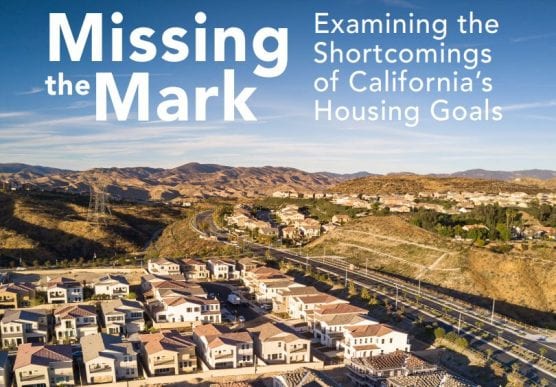SAN FRANCISCO — At the current pace of development, certain jurisdictions in California will not meet their low-income housing production targets for more than 1,000 years, according to a new brief from nonprofit think tank Next 10 and Beacon Economics.
While Santa Clarita is on track to meet its target for above-moderate-income housing in 2025, the city won’t hit its goals for low-income housing until 2060, moderate-income housing until 2571, and very-low-income housing until 2812, according to the study.
The brief, Missing the Mark: Examining the Shortcomings of California’s Housing Goals, grades the state’s 539 jurisdictions on progress toward meeting their current Regional Housing Needs Assessment goals.
RHNA targets, updated every five to eight years, determine the number of housing units at each income level that every California jurisdiction needs to permit each cycle.
The study finds most regions are chronically behind on permitting new housing units, and 100 of the 539 jurisdictions have not been participating in the reporting process at all.

“This data shows that state-wide, less than 10 percent of the RHNA-allocated low- and very-low income units have been permitted, compared to nearly half of the higher-income housing,” said F. Noel Perry, businessman and founder of Next 10.
“This disturbing trend reveals how little is being done to alleviate the affordability crisis in California, contributing to rising homelessness and displacement across the state,” Perry said.
The brief finds most jurisdictions are far behind on meeting their RHNA goals.
• The analysis finds a chronic lack of participation in the assessment process — with 100 of the state’s 539 jurisdictions having not filed an annual progress report since tracking began.
o San Diego Association of Governments and Butte County Association of
Governments are the only COGs where all jurisdictions have submitted an APR at
least once since 2013.
o The lack of reporting may be due to local capacity constraints, as the majority of jurisdictions that have never submitted an APR are lower-income areas of southeast Los Angeles County and the Central Valley.
• Only 25.9 percent of the allocated units state-wide have been permitted across all income levels, even though the current RHNA cycle is more than half over.
• The percentage completed is progressively worse the lower the income level for housing units.
o 45.6 percent of above moderate-income units have been permitted, whereas only
19 percent of moderate, 9.8 percent of low income, and 7.3 percent of very low-income units have been permitted.
o 52 percent of jurisdictions that have submitted an APR have permitted zero units
for the very low-income category.

Some jurisdictions won’t hit goals for decades, centuries
• At the current pace of very-low income housing permitting, San Francisco and Oakland will meet their very low-income goal around 2030, Los Angeles and Long Beach won’t meet their goals until closer to 2040, Palo Alto won’t hit theirs until 2063, while Santa Clara won’t hit their target until beyond 2500.
• At the above moderate-income level, San Francisco, Oakland, and San Jose will meet their goals by the end of 2019, while Riverside won’t meet their goal until after 2200, based on current permitting pace.
• Some jurisdictions are over-building higher-income housing, while not building lower-income housing.
o For example, Costa Mesa in Orange County received an RHNA allocation of zero
moderate and above moderate units but permitted 518, while permitting zero
very-low and low-income units, despite having an allocation of one unit each for
those two categories.
• For the 100 jurisdictions not reporting, the brief uses building permit data to verify that together they have permitted no more than 21.6 percent their assigned RHNA housing units for all income levels.
“RHNA was established fifty years ago to ensure communities were building housing across all economic segments,” said Adam Fowler, director of research at Beacon Economics and co-author of the report. “However, the program has no meaningful enforcement mechanism and many jurisdictions simply aren’t participating. But this is only part of why RHNA has proven to be an inefficient tool to ensure supply keeps up with demand.”

RHNA Goals Themselves Fall Short
To better capture progress toward meeting true local housing needs, this brief grades all jurisdictions on their progress meeting RHNA goals. The analysis finds certain areas of the state earning high grades — as they are on-track to meet their RHNA goals for some, if not all, income levels.
However, some of these regions have high grades because they have very low targets for housing units relative to local population. When the bar of success is so low, the RHNA targets themselves must be re-evaluated.
“If Beverly Hills can get an A because they built all three of the units allocated to them over an eight-year period, despite being forecasted to add an estimated 300 households and 3,400 jobs by 2020, you begin to get a sense that the targets themselves are part of the problem,” Fowler said.
Key Findings
• For some jurisdictions, particularly higher-income areas, the allocation of RHNA targets is misaligned with population change and job growth projections.
• Across California, grades decreased as the number of units assigned relative to
population in 2017 increased.
o The nine jurisdictions that earned an A+ on RHNA progress had an average of
only 0.7 units assigned per 100 persons.
o On the other hand, jurisdictions that earned an F had an average of 3.3 units
assigned per 100 persons.
• In the Association of Bay Area Governments, Marin and Napa counties both
received a B+. However, they have the lowest total RHNA allocation as a percentage of 2017 population (0.9 percent and 1.1 percent, respectively) compared to the ABAG-wide average of 2.4 percent. San Francisco County has the highest total RHNA assigned relative to population (3.3 percent) within ABAG.

Currently, the Department of Housing and Community Development determines how much new housing is needed in all regions of the state based on population forecasts from the Department of Finance, then HCD works with local councils of government to finalize numbers as part of the local government’s general plan housing element.
“Household formation rates are down across the state—due in part because of the existing housing crisis,” Fowler said. “By relying on this trend of declining household formation to set our future targets, we are failing to capture the extent of housing demand in the state, and guaranteeing an ongoing housing shortage.”
Looking Ahead
To address these problems of forecasting demand, the report recommends that:
• California redefine its housing need calculations to better account for historic unmet housing demand;
• Housing development be aligned with projected regional job growth to ensure there is adequate local housing for workers, rather than forcing people to live far from their place of employment; and
• Local zoning rules that favor single-family units over multi-family units be revised, to ensure communities can adequately meet their housing needs.
Governor Newsom is committed to holding regions accountable for increasing housing supply as a central priority of his first year in office. In addition to a lawsuit against Huntington Beach for failing to zone for affordable housing sufficient to meet their lower-income RHNA targets, earlier this month he met with mayors from “noncompliant” regions to encourage them to build their fair share of housing.
“More enforcement is certainly needed to compel regions to build,” Perry said. “But
ultimately, the state must look at how RHNA goals are developed in order to ensure that they don’t exacerbate a chronic shortage of housing through targets that maintain the status-quo, rather than adequately reflect the true housing needs around the state.”
About Next 10
Next 10 (next10.org) is an independent, nonpartisan organization that educates, engages and empowers Californians to improve the state’s future. With a focus on the intersection of the economy, the environment, and quality of life, Next 10 employs research from leading experts on complex state issues and creates a portfolio of nonpartisan educational materials to foster a deeper understanding of the critical issues affecting our state.
About Beacon Economics
Beacon Economics is one of California’s leading economic research and consulting firms, specializing in economic and revenue forecasting, economic impact analysis, economic policy analysis, regional economic analysis, real estate market and industry analysis, and EB-5 Visa analysis. Known for delivering independent and rigorous analysis, Beacon Economics works to give clients an understanding of economic trends, data, and policies that help strengthen strategic decision-making. Clients range from the State of California to Fortune 500 companies to major cities and universities. Learn more at www.BeaconEcon.com.
Like this:
Like Loading...
Related





 Tweet This
Tweet This Facebook
Facebook Digg This
Digg This Bookmark
Bookmark Stumble
Stumble RSS
RSS
































REAL NAMES ONLY: All posters must use their real individual or business name. This applies equally to Twitter account holders who use a nickname.
0 Comments
You can be the first one to leave a comment.